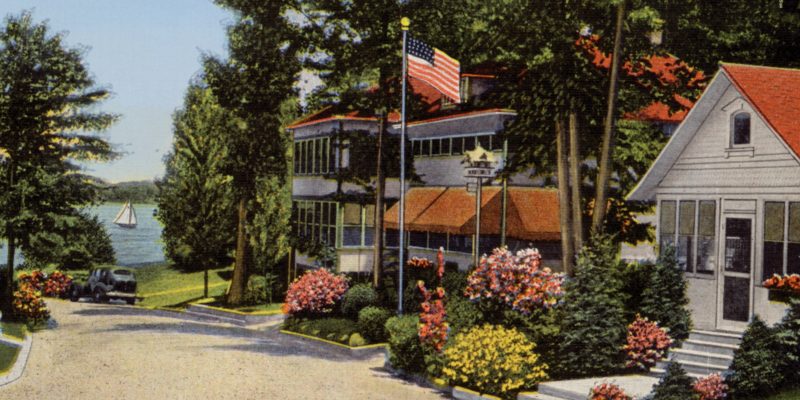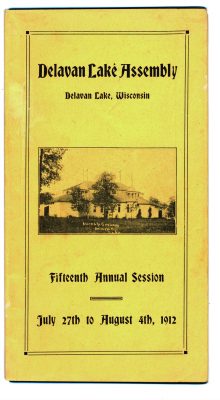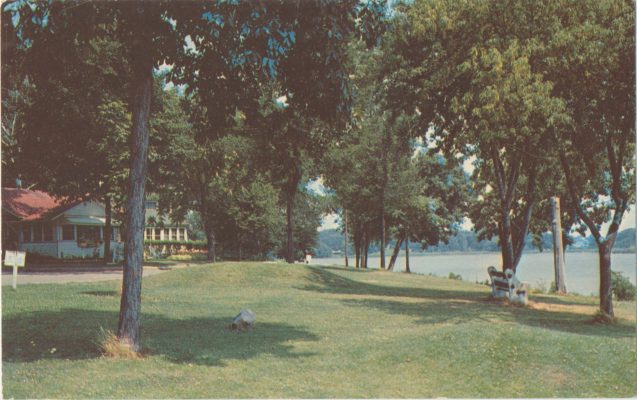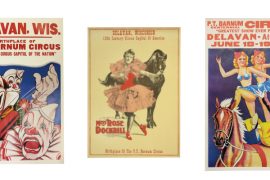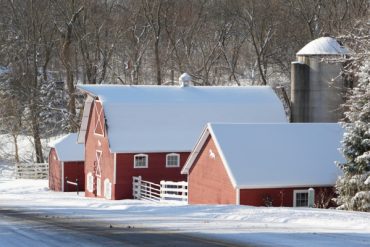By Shelby Deering
As soon as the sun rises, the sounds of early morning harmonize like a chorus. First, there are the waves lapping gently at the shore. Then the seagulls join in, making their first catches of the day. Then there’s the opening and closing of screen doors, which leads to the quiet hum of friendly conversation. Another summer day has begun at Assembly Park.
Located only five minutes from Delavan’s Lake Lawn Resort, this storied private community has been alive and well for over 120 years, still welcoming people with open arms. With a mix of seasonal and full-time residents, Assembly Park looks as if it’s traveled in a time machine, and for the most part, seems greatly unchanged since the 1950s.
The playground equipment, colorful and well-loved, has been used for decades, even by today’s kids who choose to leave their cell phones back at their cottages. Folks gather together for pancake breakfasts, spaghetti dinners and Friday night dances. The speed limit is set at 10 miles per hour. People walk their dogs and wave to one another as if they’re family. And everyone takes care of each other.
The ebb and flow of Assembly Park has remained virtually the same since the turn of the 20th century. In the spring, it seems as if the land patiently awaits the return of the residents. When Memorial Day arrives, Assembly Park awakes in all of its summertime glory, complete with lunchtime barbecues, afternoon boat rides and evening swims. In addition to all this fun, you can feel the history of the place as it continues to permeate long-standing homes and family lineages.
Let’s take a trip to Assembly Park, a slice of paradise here in the Lakes Area.
THE EARLY DAYS
Assembly Park’s roots are intertwined with Delavan’s beginnings. Before settlers arrived, the land was home to Native Americans, who built effigy mounds on the property. Although many of these burial mounds didn’t survive when Assembly Park was built, a few can still be found today.
Centuries later, the property came to serve a very different purpose as a circus grounds.
John Neville, a resident since 1970 and the keeper of the community’s history, explains that before it was Assembly Park, the Mabie Brothers Circus purchased the property in 1847. After years of wintering there, in 1898, the heirs sold the 38 acres, nicknamed “Mabiewood,” to the Delavan Lake Assembly Association, a group of five businessmen, for $15,000.
The Delavan Lake Assembly Association was formed as a licensed corporation — the businessmen bought the land, broke it up into lots and created 99-year leases for those lots. The leases expired in 1998 but were then extended until 2075. Today, Assembly Park residents, or “leaseholders” as they’re called, continue to own their individual homes on leased property. Currently, there are 211 cottages in the association. Neville explains, “There is a general lease agreement. Technically, the board of directors owns every lot that’s in here. They own and administer the whole 38 acres.”
The founding fathers had a vision beyond the leases they provided, and they wanted to carry it out on this very piece of Delavan Lake shoreline.
“Those five men wanted to start a Chautauqua,” Neville says. A Chautauqua was a unique education movement that blossomed in the late 19th century, centering around lectures, concerts and hands-on learning opportunities for adults. Neville elaborates, saying, “The first Chautauqua was on Lake Chautauqua in New York. It was a recreation area that was dedicated to summer sports, aquatics, education, religion and politics. People typically came in the month of June for two or three weeks.”
Overseen by John Jay Phoenix, a relative of Delavan’s founders, they began a Chautauqua-inspired program on the property called Assembly Grounds, named after the corporation that spearheaded the project. Small cottages already began to spring up when the land was owned by the Mabies, and the program was built up around them.
From 1898 to 1914, the area flourished with its adult-education programming. The Assembly Auditorium was completed for the 1899 season, and it held up to 3,000 attendees. People took part in classes and lectures led by movers and shakers of the day, including William Jennings Bryan, a three-time presidential candidate. Season tickets were $2.50, and the dining hall served 2,000 meals a day.
The area buzzed with thousands of visitors, many pitching tents and coming with horse-drawn wagons, much to the dismay of the residents who lived there year-round.
Overcrowding continued to be a problem, and the Chautauqua programming ended in 1914. A few featured speakers, like former President William Howard Taft, did come to the auditorium after that, but the heyday of Delavan’s Chautauqua movement was over. In 1919, the auditorium burned down due to an electrical issue, and the area was transformed into an idyllic neighborhood.
MAKING MEMORIES
After World War II, the name of the property changed to Assembly Park, and it became known to Chicago-area families as a summertime utopia. Scores of people have built or purchased cottages on the land, including Michael Connolly’s family. Connolly serves as president of Assembly Park’s Board of Directors, and his family has been coming to the area since the 1950s.
“Even before that, my dad came up as a kid,” Connolly says. “We lived to get in the station wagon and drive up for one week. We rented a tiny cottage that had two bedrooms for seven of us, and somehow, we managed. No one ever complained. We were just thrilled to be here.”
In 1967, Connolly’s parents purchased the cottage he still resides in. When he looks back on those summer days of his youth, Connolly perfectly captures the spirit of Assembly Park.
He says, “The beach was packed, and we had everything you’d expect a resort area to have. We had four parks with great equipment that was always being used. And we had a baseball field. There wasn’t one day we weren’t out there playing softball and football.”
Connolly’s favorite thing about Assembly Park was a small store called My Brother’s Place. It sold groceries to the leaseholders and served up meals that hit the spot after a long day of playing outside.
“In the middle of the day when you’ve just played softball, you could go and sit at an old-time counter with chrome seats and a wraparound counter and grab a lemonade and a burger. It was just great,” Connolly says. He adds that he also loved the tiny fried doughnuts they served, called “widgets,” and the penny candy, too. Even though it’s no longer standing today, several residents continue to have fond memories of the store.
The current caretaker of Assembly Park, Rob Mohr, who Connolly says plays an instrumental role for the property and its residents, has a personal connection to My Brother’s Place. Mohr is a third- generation resident, whose family once owned and operated the popular store.
My Brother’s Place was a natural gathering place for the park but many leaseholders also took part in something called “Thursday Night Dances.” Geared toward the little ones of Assembly Park, tables and chairs were pushed aside in Assembly Hall, (the community’s social hub originally built in the 1940s) and kids danced the night away to the Bunny Hop and the Hokey Pokey. Still held today, the dances now take place on Friday nights. “People wanted to carry on the tradition with their own children,” Connolly says.
To add to the Norman Rockwell-like quality of Assembly Park, newspapers used to be delivered by teenagers pulling wagons, acting as Sunday alarm clocks as they bellowed out, “Chicago papers!”
HISTORIC HOMES
Several of Assembly Park’s original cottages make up the current-day neighborhood. Among the 211 cottages, many still look as if they haven’t changed a bit from the vintage postcards and black-and-white photos.
The oldest structure in the park, the “Old Kentucky Home,” had its beginnings in the late 19th century and continues to be enjoyed as a summer home. Generally, cottages are passed down from one generation to the next. The Bestul family has resided in Assembly Park since as early as 1913, a tradition that takes place among many families in the community.
“Passing homes from generation to generation is certainly a tradition that’s kept. If you grew up here, it can be very hard to let a home go,” Connolly says.
ASSEMBLY PARK TODAY
Connolly and Neville agree that little has changed since they first came to Assembly Park. That’s definitely true of the neighborhood’s myriad events, like the Fourth of July parade or the September Arbor Day celebration that features classic diversions like knapsack races, pony rides and face painting.
But as Connolly says, “You can’t stop progress,” and so even though Assembly Park has maintained its time-honored traditions, it has experienced improvements. For example, an architectural review committee was formed recently to confirm that all the homes follow similar cottage styles. In addition, two years ago Assembly Park installed eco-friendly permeable paver roads that protect the lake by preventing water run-off. The association also added environmentally-friendly LED lights along the lake to avoid light pollution. But at the end of the day, Assembly Park is a pristine place that’s been frozen in time, one that holds fast to its values.
Chris Gulotta, a relative newcomer to Assembly Park, calls the community his “happy place.” He says, “You come here. You put the car in park and you open the doors. The kids are gone. You don’t see them again until dinnertime and they get the run of the park. There’s nothing to worry about.”
Connolly appreciates the neighborly aspects of Assembly Park. “I don’t want to say I’m not a neighbor person at home,” he says. “But I enjoy being able to walk down almost any street [in Assembly Park] and I can say hello to someone I know. It’s a really close- knit friendly group. It’s a big family.”
Neville relishes the timelessness of Assembly Park, saying, “In the 1950s when we were children, there was always the sound of the screen door opening in the summertime, the blur of a kid racing through and then the sound of the door shutting. That still goes on here today. We love our families and we love our traditions, and it’s our dearest intent to keep them.”

